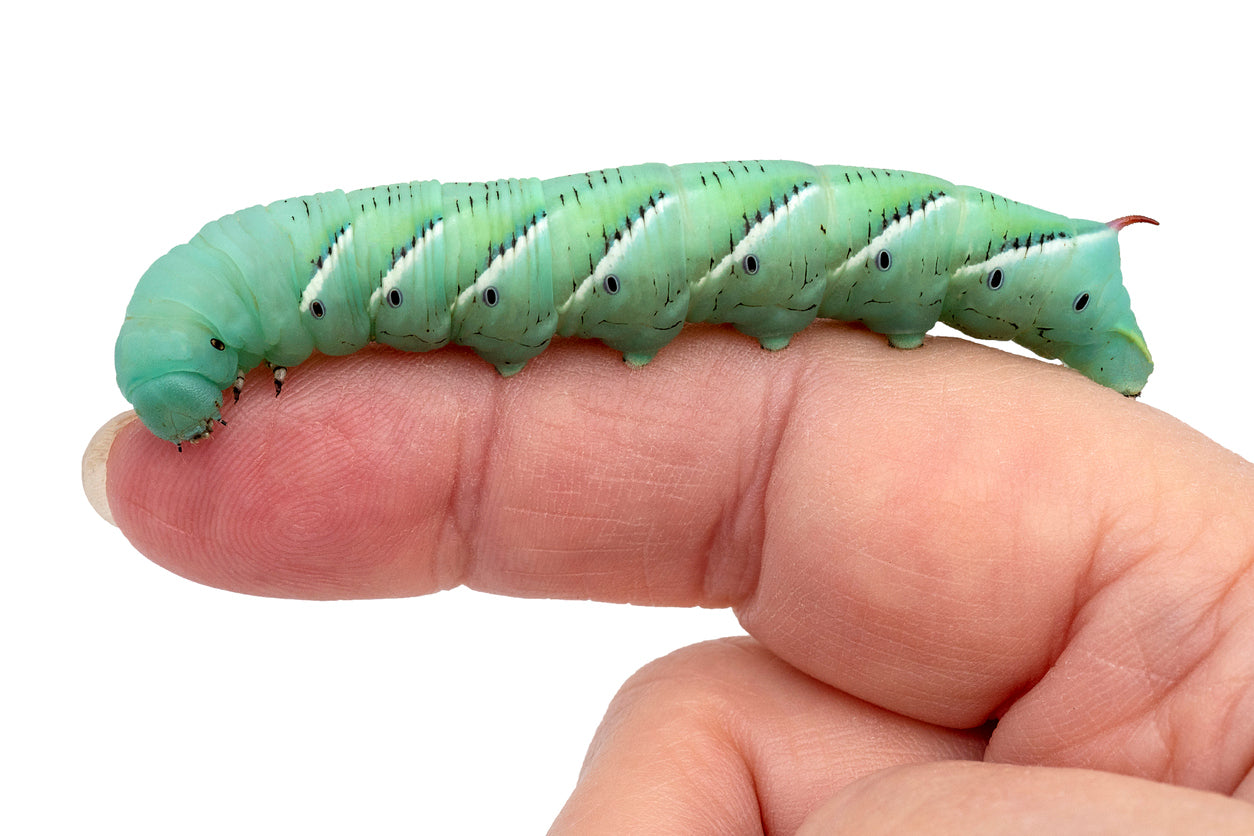
Frequently Asked Questions - FAQ Hornworms
Hornworm question quicklinks:
To help you navigate our frequently asked questions on Hornworms so you can find your answer more quickly
- What are Hornworms?
- Nutritional Information for Hornworms:
- Will hornworms give my pet diarrhea?
- What do hornworms eat?
- How do I keep my hornworms?
- How big will my hornworms get?
- Does the "horn" hurt my pet?
- What will my Hornworm turn into?
- What happens if my order arrives dead?
- What if I receive the wrong item?
- What if I receive someone else’s order?
What are Hornworms?
Hornworms, also known as Tomato Hornworms, are the larval stage of the Manduca quinquemaculata, the Hawk Moth. They are known as the Tomato hornworm as when they are in the wild. Hornworms are viewed as pests because they feed on tomato plants and other garden variety plants. Hornworms in the wild tend to be green, whereas the ones we use as feeders are more of a teal/blue due to having a different diet.
Nutritional Information for Hornworms:
- Moisture 85%
- Protein 9%
- Fat 3.07%
- Ash n/a
- Fiber n/a
- Calcium 464mg/kg
- Phosphorous 1394mg/kg
Will hornworms give my pet diarrhea?
It is possible. This is a common question as hornworms are well known for having a high water content. As long as you are careful with how many that you feed and how big they are when you feed them, then you shouldn't have too much of an issue. If you notice signs of overhydration regarding your pet, then cut back on the hornworms.
What do hornworms eat?
In the wild, hornworms eat a variety of plants, but as feeder insects, a powder mix is used, which is made from mulberry leaves and formed into a paste that is added to the cups that the hornworms arrive in so they can eat it. You can purchase extra hornworm food if you want some extra so you can keep them from running out. Since they grow very fast, they can run out if you are planning on trying to keep them for longer than a week.
How do I keep my hornworms?
When you buy hornworms, they arrive in a cup; a mesh will be secured to the middle of the container, which is used by the Hornworm to climb up and eat the food, which is a paste that is pressed into the top of the cup. All you need to do is keep them upside down so that their poop falls to the bottom in the form of small brown pellets that need to be cleaned out daily. Try to keep the lid where it will have ventilation so they will have some air. Hornworms grow VERY FAST, especially if they are kept warm, so if you want to try and keep them from becoming too big, then you will need to keep them somewhere cool that isn't the fridge, which is too cold for them. If they seem to be running out of food, you will want to feed them off, or they could die, you can buy extra hornworm food if this is a concern. See our guide on how to care for your hornworms for more detailed information.
How big will my hornworms get?
They will grow up to 3" or 4" if allowed to get to full size; depending on the temperature, this could be anything from a week to two weeks. They usually live up to 3 or 4 weeks before they either die or pupate into moths.
Does the "horn" hurt my pet?
The actual horn of the Hornworm is not hard; it is just for show to scare off predators and will not hurt your pet when the Hornworm is eaten.
What will my Hornworm turn into?
Hornworms turn into the Hawk Moth. Generally, hornworms get fed off before they have the chance to pupate. However, if you kept a couple of weeks or longer, then you may notice your hornworms pupate. When they begin to turn, they will become a dark brown/red color and form a hard shell. Eventually, they will emerge as a hawk moth. This can be a fun project to do with your kids if it does happen. Unfortunately, you should not release the moth into the wild as they are considered pests, and this could upset the local fauna.
What happens if my order arrives dead?
Every effort is always taken to ensure that your order arrives alive, we always pack more bugs into our shipments just in case. On the off chance that your order does arrive dead, just send us a photo of the dead bugs in the container they came in and we will send you a replacement or issue you a credit on your account as long as the package has not been left outside to sit for longer than 1 hour.
What if I receive the wrong item?
If you receive the wrong item, please send us a message with your order number, the item you received, and the item you were supposed to receive. We do make mistakes, but we would be happy to send a replacement order.
What if I receive someone else’s order?
This doesn’t happen very often, but there is always a chance we may mix up a packing slip or shipping label. If this happens, just send us the order number of the order you received, and your order number so we can send a replacement order.
If you have any questions that haven't been answered here, go to the page for your product in question and scroll to the customer reviews and post your question there.

Comments
Leave a comment